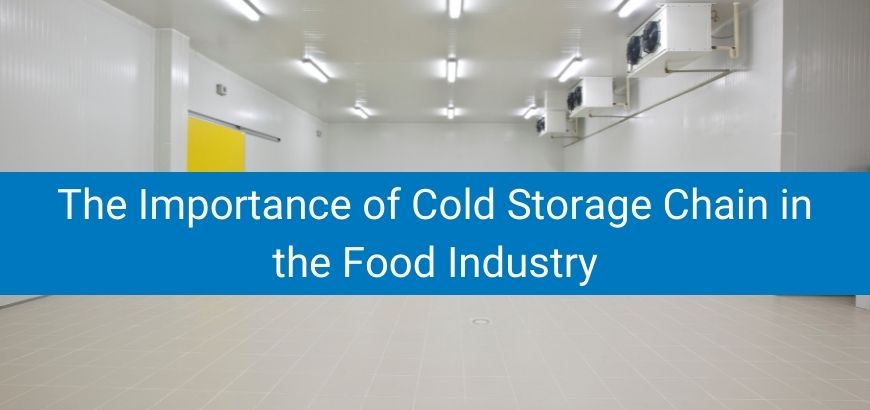What Are the Main Causes of Food Spoilage
There are multiple factors involved in food spoilage, leaving the food and even biological products, vaccines and pharmaceuticals unfit for use or consumption.
- Temperature
- Light
- Heat
- Oxygen
- Humidity
- Microbial growth (bacteria, fungus, molds, yeast, etc.)That is why humidity and temperature-controlled environments are critical in maintaining the integrity, freshness, taste, texture and safety of food products.
What Is Food Cold Chain?
A food cold chain can be defined as a set of activities to ensure that perishable food items are kept or stored at the optimum temperature range throughout the supply chain—from harvesting to reaching the end consumers at the point of sale. It includes a robust network of the following:
Simply put, an effective cold chain seamlessly maintains the temperature of the perishable, sensitive food during the movement from the farm to the final destinations including storage and distribution.
The global food cold chain market was estimated at USD 149.43 billion in 2019, of which refrigerated storage is observed to be the fastest growing segment owing to technological advancements. It is projected that the refrigerated storage segment will account for 59% of the market by 2024.
Cold Chain for Agricultural and Seafood Products
Primarily, the cold chain for agricultural and seafood products can be categorised under the following six categories.
- Harvesting: Food deterioration can occur as soon as after harvesting. For instance, fish needs ice and milk requires cooling right after milking.
- Preconditioning: The obvious next step is that the produce needs to be cooled to an optimum temperature, sorted and packed. For onward transportation in a vehicle or container, some products need to be kept in refrigerated storage while others need to be cooked, processed, chilled (blast chillers) or frozen.
- Logistics: Different modes of transport including refrigerated or eutectic trucks, freight, etc. are used for the movement whilst maintaining stable temperature and humidity levels.
- Storage: The bulk of products arriving at the warehouses also need proper storage conditions for maintaining the inventory and last-mile delivery. Moreover, there can be multiple products that may need varying temperatures, requiring specific storage solutions.
- Retail: In retail, for both display and temporary storage before customers buy the product, items need to be kept and maintained at a low temperature.
- Domestic consumption/food service: Again, products that were refrigerated or frozen during their supply chain need to be kept in the same conditions in the domestic set-up or the hospitality sector before being consumed or served to the customers.Also, depending on the type of food product or good, the temperature range varies during transportation, storage, and distribution. For instance
- Seafood or meat exports: -28 °C to -30 °C also known as deep freeze
- Meat and certain types of produce: -16 °C to -20 °C (Frozen)
- Fruit & vegetables, fresh meat, and some dairy products: 2 °C to 4 °C (Chill)
- Medicines, vaccines or pharmaceuticals: 2 °C to 8 °C
- Fresh produce, processed food, and over-the-counter drugs: 12 °C to 14 °C
Why Is Cold Chain Important in the Food Industry
Cold chain offers numerous benefits in the food industry
- Reduced goods wastage which may affect the inventory, as well as the shipment and replacement costs.
- Reduced chances of poor quality products reaching your end customers, enhancing customer’s satisfaction levels and your reputation. This also means fewer liabilities and disputes.
- Improved product safety, quality, and integrity.
- Access to new markets with transportation, increasing business opportunities and exports.
- Improved regulatory compliance especially for pharmaceutical and food products.
- Increased business efficiency due to better monitoring, delivery and storage of perishable goods.
Challenges in the Food Cold Chain
Some of the common food cold chain challenges include the following.
- Inability to trace the food or produce throughout all the stages of the supply chain. Lack of traceability and transparency can increase the risk related to the safety and integrity of the product.
- Difficulty in maintaining the safety or quality of products due to poor cold storage or warehousing infrastructure and practices, transportation inefficiencies, weather unpredictability, and so on.
- Lack of communication between the parties involved across the supply chain.
- Increasing costs related to the fuel and energy prices, manpower, freight cost, and others.
How Can Rinac Help
Being a pioneer in innovative cold chain storage solutions, Rinac has worked extensively alongside leading industrial players to develop real-world solutions to tackle food cold chain challenges. Our industrial cold chain solutions cater to a vast array of industries and include walk-in and step-in chillers or freezers, refrigerated transportation, multi-commodity cold warehouses, display cum cold storage units, and much more.
To know more about how we are transforming the food industry, click here!



